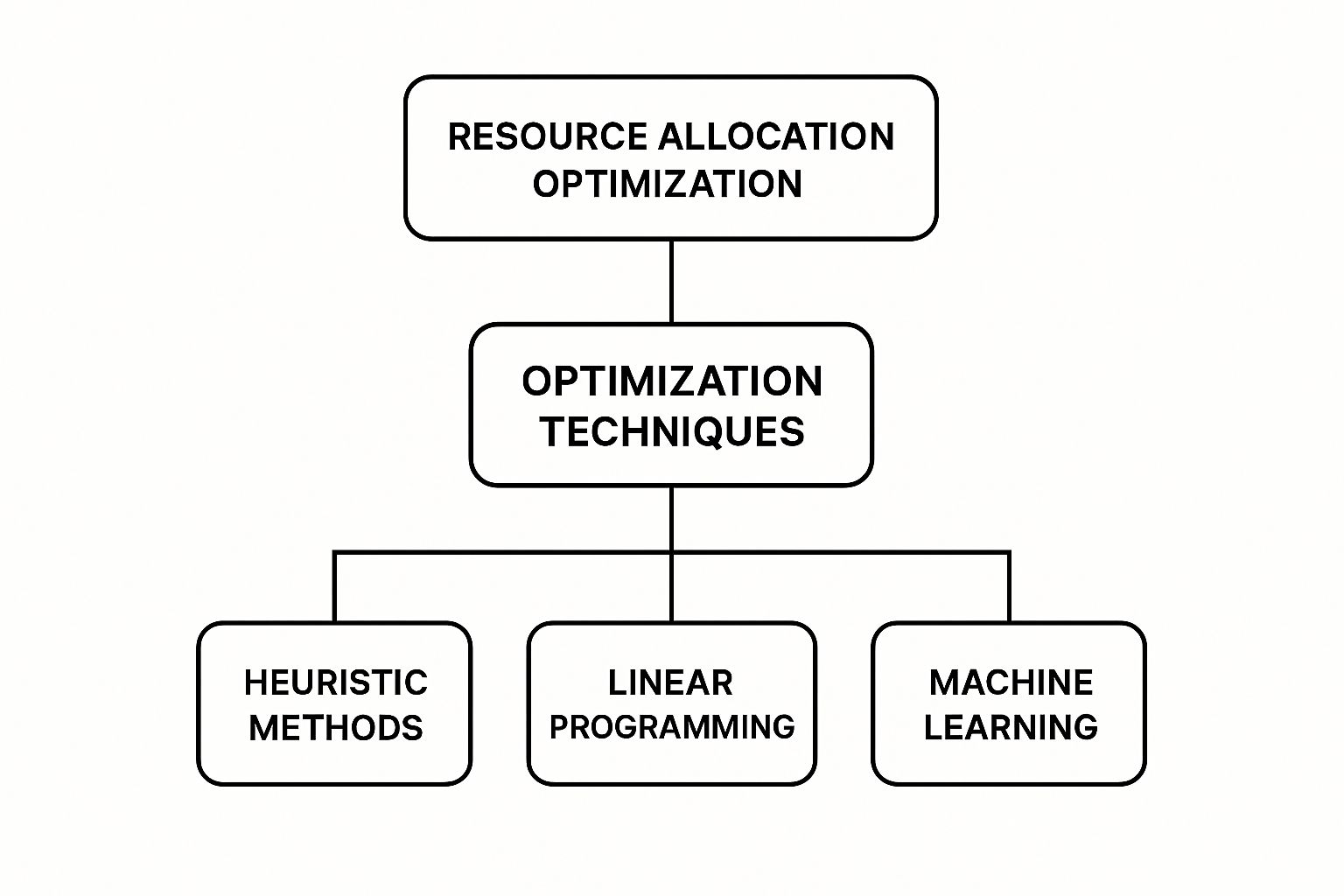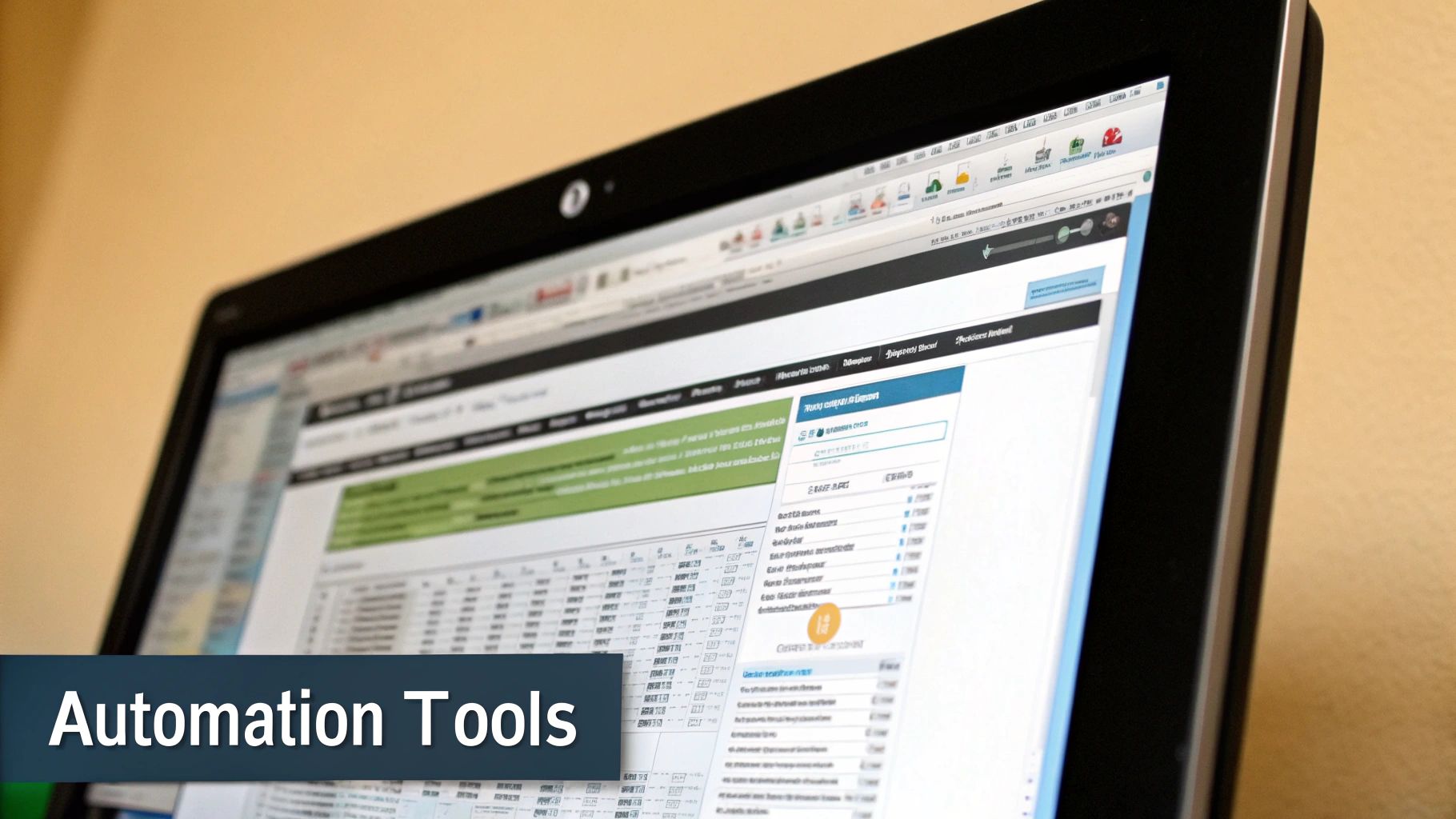Mastering Resource Allocation Optimization
At its most basic level, resource allocation optimization is all about putting your company's assets—things like money, equipment, and your team's valuable time—to the best possible use. It's the art of making sure every single resource is pulling its weight to hit your business goals, cutting out waste and getting the most bang for your buck.
What Is Resource Allocation Optimization Really About?

Think of it like being the head chef in a packed restaurant on a Saturday night. You’ve got a limited amount of fresh ingredients (your resources), a kitchen crew with different skills (your team), and a constant stream of orders coming in (your projects).
Resource allocation optimization is how you decide which cook gets which dish and which ingredients to use, all in real-time. The goal? To get every meal out perfectly and on time, without running out of salmon or burning through your prime cuts on a low-profit special. It's less about filling out a spreadsheet and more about turning potential chaos into a smooth, profitable service.
The Three Pillars of Optimization
To get this right, you have to juggle three key components. They all work together, forming the foundation for every smart decision you make about where to focus your company's energy and assets.
- Resources: This is everything you have to work with. It includes the obvious things like project budgets and software, but most importantly, it’s about your team's time, skills, and expertise.
- Constraints: These are the real-world limits you can't ignore. We all face them—tight deadlines, fixed budgets, not enough people, or dependency on a specific piece of technology.
- Objectives: This is the "why" behind it all. It’s the specific goal you're trying to hit, whether that's launching a new product, grabbing more market share, or boosting customer satisfaction scores.
True optimization is a constant balancing act. It’s about navigating the give-and-take between these different priorities to get the best possible result.
At its core, effective workload scheduling is not about finding the single best solution, but rather navigating a multi-dimensional constraint optimization problem. It is less about overcoming strict limitations and more about finding trade-offs between competing priorities.
From Theory to Strategic Action
When you start thinking this way, resource allocation stops being a simple management chore and becomes a serious strategic advantage. It forces you to ask the tough, important questions that really drive the business forward.
Which project offers the biggest return on investment? Is my top engineer bogged down in meetings, or do they have the focused time they need to crack our most complex problem?
Adopting this mindset means every dollar you spend and every hour your team works is directly tied to what matters most. It’s how you turn big-picture ambitions into a concrete plan of action. Mastering this skill is what moves your company forward, making it more efficient, agile, and ultimately, more profitable.
Why Resource Optimization Is Your Competitive Edge

Most businesses think of resource allocation optimization as just a cost-cutting exercise. A way to trim the fat. And while saving money is certainly a nice benefit, that view misses the bigger picture entirely.
Smart resource allocation is the invisible engine that propels market leaders forward, leaving the competition sputtering in their dust. It’s about creating a powerful, sustainable competitive advantage.
Let's imagine two rival tech startups, "AgileLaunch" and "ChaosCorp." Both are staffed with talented people and have great product ideas. But how they manage their resources couldn't be more different.
At ChaosCorp, it’s a free-for-all. The top engineers get yanked from one "five-alarm fire" to the next, with little regard for actual priorities. New projects kick off without anyone checking if the team can actually handle the workload. This leads to constant context-switching and a permanent state of crunch, resulting in missed deadlines, buggy software, and burned-out employees.
AgileLaunch, on the other hand, approaches resource allocation as a core business strategy. They have a system for prioritizing projects based on real business impact. They use data to understand who’s working on what, ensuring their best people are on the tasks that matter most. They operate like a finely tuned machine, shipping better products faster and keeping their team happy.
Turning Efficiency Into Market Dominance
The gap between these two companies isn't just an internal issue; it spills directly into the marketplace. AgileLaunch’s methodical approach gives them a massive leg up in several key areas.
- Faster Time-to-Market: By focusing their energy on top-priority projects and clearing away bottlenecks, they consistently launch new features before ChaosCorp. They get to capture the market's attention first.
- Higher Profitability: Using resources wisely translates to lower project costs and fewer costly blunders. Every dollar they invest goes further, which fattens their bottom line and frees up cash for their next big idea.
- Improved Agility: When a new opportunity pops up, AgileLaunch can pounce. They know exactly who is available and can shift resources on a dime, while ChaosCorp is still trying to figure out who’s working on what.
For ChaosCorp, failing to optimize isn’t just inefficient—it’s a direct threat to their survival. As the two companies go head-to-head, AgileLaunch’s smart use of its people and budget becomes its most potent weapon.
The High Cost of Inaction
Ignoring resource allocation creates hidden drags on a business that can become crippling over time. Think about large global companies with operations scattered across countries. Fragmented data systems often lead to an estimated $50 million loss in missed opportunities each year and cause around 15% redundant resource allocation.
In these siloed organizations, decision-making can be up to 40% less efficient than in companies with a unified view of their operations.
Failing to optimize resources is like trying to win a race with a leaky fuel tank. No matter how powerful your engine is, you'll eventually run out of gas, while your competitor, who managed their fuel perfectly, crosses the finish line.
Ultimately, mastering resource optimization means getting better at making more with less. It’s how a company turns operational excellence into a real, lasting market advantage. This discipline is a cornerstone of building a resilient and profitable business, a topic we explore further in our guide on how to improve operational efficiency.
Core Methods for Smarter Resource Allocation
So, we've covered why optimizing your resource allocation is a game-changer. But how do you actually do it? This is where the rubber meets the road. Let's get into the practical, proven methods businesses use to make smarter, data-driven decisions every single day.
Think of these methodologies as different tools in your operational toolkit. Each one offers a unique way to tackle a resource puzzle, whether you're dealing with a straightforward scheduling conflict or a massive, multi-faceted project with a dozen moving parts.
This image breaks down how various techniques fit under the broader umbrella of optimization.

You can see that each branch represents a different path you can take, depending on your specific needs and how complex the problem is.
Linear Programming: The Mathematical Approach
At its heart, linear programming is a powerful mathematical technique used to find the absolute best outcome when you're working with a set of limitations.
Imagine you're a portfolio manager with a set budget. Your goal is to get the highest possible return without exceeding a certain level of risk. Linear programming is the formula that would pinpoint the perfect mix of stocks and bonds to achieve that. For a business, it could mean figuring out the most profitable production schedule given your limited supply of raw materials. It's perfect for when you have a crystal-clear goal (like maximize profit) and firm constraints (like budget or time).
Heuristic Methods: The Practical Rules of Thumb
While linear programming chases the perfect mathematical answer, heuristic methods are all about finding a good, solid solution—fast. Think of a veteran project manager juggling three projects at once. They aren't running complex algorithms; they're relying on gut instinct and battle-tested "rules of thumb" they've picked up over the years.
A classic example is always assigning the most difficult task to your most skilled team member first. It might not be the mathematically optimal solution down to the second, but it’s a quick, effective strategy that almost always works. Heuristics are the savvy shortcuts that prevent "analysis paralysis."
A huge part of this involves strategically designing your data analytics team structure, which often leans on heuristic principles to match the right skills with the right roles.
The Critical Path Method: Identifying What Truly Matters
The Critical Path Method (CPM) is a project management classic for a reason. It laser-focuses on identifying the sequence of tasks that absolutely must be completed on time for the entire project to succeed.
It’s like planning a cross-country road trip. The critical path is the one interstate you can't avoid; any traffic jam on that highway will make you late to your destination, no matter how clear the side roads are.
By putting your best resources on the "critical path," you ensure the most important dominoes fall on schedule. This prevents bottlenecks and keeps the whole project flowing smoothly.
CPM helps you nail down answers to essential questions:
- Which tasks have absolutely no wiggle room in their deadlines?
- Where should I place my top performers to prevent delays?
- If a task gets delayed, what's the ripple effect on the rest of the project?
It forces you to focus on what's non-negotiable.
Dynamic Programming: Breaking Down Big Problems
Finally, there's dynamic programming. This clever method solves massive, overwhelming problems by breaking them down into smaller, more manageable sub-problems. It’s the same logic you'd use to tackle a 1,000-piece jigsaw puzzle: you start with the corners and edges, assemble small sections of color, and then fit those completed chunks together.
This approach is incredibly useful for multi-stage planning, like managing inventory levels over a fiscal year or developing a long-term financial strategy. By solving each small piece of the puzzle perfectly and remembering that solution, you can build your way up to the best possible outcome for the entire challenge.
Comparing Resource Allocation Methodologies
Each of these methods brings something different to the table. Choosing the right one depends entirely on the nature of your project, the complexity of your constraints, and how much time you have to find a solution.
Here’s a quick breakdown to help you see how they stack up.
| Methodology | Best For | Complexity | Key Benefit |
|---|---|---|---|
| Linear Programming | Problems with clear objectives and fixed constraints (e.g., supply chain, production planning). | High | Delivers the mathematically optimal solution for maximizing profit or minimizing cost. |
| Heuristic Methods | Dynamic, fast-paced environments where a "good enough" solution now is better than a perfect one later. | Low | Speed and simplicity. Provides practical, quick answers without deep analysis. |
| Critical Path Method | Time-sensitive projects with interdependent tasks (e.g., construction, software development). | Medium | Identifies and prioritizes tasks that directly impact the project deadline, preventing delays. |
| Dynamic Programming | Complex, multi-stage problems that can be broken down into smaller, sequential pieces. | High | Solves enormous problems by finding optimal solutions for sub-problems first. |
As you can see, there's no single "best" method. The smartest leaders have a versatile toolkit and know which tool to pull out for which job to truly master resource allocation optimization.
Looking Back to Move Forward: How Your History Shapes Future Wins

Your company’s history isn't just a record of wins and losses; it's a playbook filled with clues for your next big success. The secret to smart resource allocation optimization is learning to look backward to see what's coming. It’s all about turning the data you already have into your most powerful strategic tool.
Think of it like a coaching staff reviewing hours of game footage. They aren’t just reliving the match—they’re breaking it down to find patterns, spot the other team's weaknesses, and see what their own players did right so they can do it again.
That same level of analysis is exactly what your business needs. By digging into past projects, you can uncover those sneaky inefficiencies that drain your budget, get way better at predicting future needs, and start making proactive decisions instead of constantly playing catch-up.
Finding the Hidden Stories in Your Data
The first step is to go deeper than a simple P&L statement. Knowing a project went over budget is one thing, but understanding why is where the real value lies. Digging into your project history lets you ask the right questions to uncover the root causes of what went right and what went wrong.
To get started, try focusing your analysis on a few key areas:
- Task Effort vs. Reality: How did your estimated hours for a task stack up against the actual time logged? If a specific phase of a project consistently takes 20% longer than you thought it would, you've just found a recurring blind spot in your planning.
- Workload Balance: Take a hard look at how work was spread across the team. Was one person constantly buried in tasks while another had free time? This kind of imbalance is a recipe for burnout and missed deadlines.
- Asset Utilization: Think about your non-human resources, like expensive software licenses or specialized equipment. Were they sitting idle most of the time? That's a clear signal that you might be overspending.
By digging into this kind of data, you start to see the patterns that shape your operations. Businesses that get good at this can use analytics to find correlations that help them forecast needs and distribute work more effectively. You can learn more about this data-first mindset and its impact on operational intelligence on akooda.co.
From Reporting to Predicting
Once you start spotting these patterns, you can make a powerful shift. You move from just reporting on what happened to accurately predicting what will happen. This is the leap from reactive management to true strategic forecasting, a cornerstone of effective resource allocation optimization.
For example, if you see that every Q4 project demands more graphic design time for holiday campaigns, you can book freelance help months ahead of time. No more last-minute scrambles that blow the budget and lead to rushed, sloppy work.
Your historical data is like a crystal ball for resource management. It doesn't show you a perfect future, but it reveals the most likely one, giving you the time you need to prepare.
Building a Smarter Allocation Model
Armed with these insights, you can build a much more intelligent model for allocating resources. This isn't about creating rigid, unbreakable rules. It's about developing informed guidelines that empower your managers to make better calls in the moment.
Here’s a practical way to put this into motion:
- Create Your Baselines: Use past project data to set realistic benchmarks. Now you'll know that a "standard website build," for instance, typically requires a certain number of hours from development and QA.
- Flag the Risk Factors: Pinpoint the variables that have caused delays or cost overruns in the past. If you know that including a particular stakeholder always adds 15% to the timeline, you can build that buffer into your next project plan from day one.
- Keep Refining: Your resource plan should be a living document, not a static one. Constantly compare your forecasts to the actual results, and use that fresh data to make your next round of predictions even sharper.
This systematic approach turns resource allocation from a high-stakes guessing game into a data-backed science. It gives you the power to stop repeating old mistakes and start building a more predictable, efficient, and profitable future.
Using AI and Analytics to Predict Your Needs
Think of Artificial Intelligence as a strategic co-pilot for your business. It's not here to take over the controls, but to give you a massive upgrade in visibility and foresight. Imagine having a smart GPS that doesn't just show you the best route but actively reroutes you in real-time to avoid traffic jams you can't even see yet.
That’s what AI and predictive analytics do for resource allocation optimization. They dig through enormous amounts of data to forecast demand, spot potential roadblocks, and suggest the smartest way to deploy your resources before a problem ever surfaces. It’s a complete shift from reactive firefighting to proactive, strategic planning.
These advanced tools are more accessible than ever, delivering real-world results like lower costs, a serious boost in productivity, and a more resilient business. Exploring AI for business automation can open up entirely new levels of efficiency, and you can learn more by leveraging AI for streamlined business automation.
How Predictive Analytics Works
So, how does this actually work? Predictive analytics uses your historical data, combined with machine learning and statistical models, to make incredibly educated guesses about the future. Using techniques like regression analysis and time series forecasting, it helps you anticipate everything from customer demand and workload spikes to supply chain hiccups. You can find more detail on these analytical techniques on JERR.
But this goes way beyond just spotting simple trends. AI models can uncover subtle, complex patterns that even the sharpest human analyst might overlook.
For example, an AI might connect the dots between a recent marketing campaign, a small increase in customer support tickets three weeks later, and a subsequent need for a specific type of software developer. Armed with that insight, a manager can schedule extra support staff and book developer time ahead of schedule, completely preventing a bottleneck before it has a chance to form.
AI doesn't just show you what happened; it builds a model of your business's rhythm, allowing you to anticipate the next beat and prepare for it perfectly.
Key AI-Powered Capabilities
When you bring AI and analytics into your resource management, you unlock some powerful capabilities that used to be pure science fiction for most companies. These tools turn messy, complex data into clear, actionable advice.
Here are a few of the biggest game-changers:
- Demand Forecasting: AI can look at past sales, market trends, and even seasonal spikes to predict future demand with startling accuracy. This means you always have the right people and products ready to go, avoiding costly overstaffing or embarrassing stockouts.
- Automated Skill Matching: Imagine a system that knows every employee's skills, certifications, and project history. When a new project pops up, the AI can instantly suggest the perfect team, slashing the time you spend on manual planning.
- Risk Identification: Think of AI as an early warning system. By keeping an eye on project progress and communication patterns, it can flag projects that are at high risk of falling behind schedule or going over budget, giving you a chance to step in early.
- Scenario Simulation: Before you lock in a plan, you can ask the AI to run "what-if" scenarios. What happens to our deadline if a key engineer gets sick? How much will a supplier delay cost us? The AI can give you data-backed answers in minutes, not days.
By adopting these tools, businesses can move from gut-feel decisions to ones backed by solid data. This is what modern, high-performing organizations do, and it’s an essential part of successful resource allocation optimization.
Your Framework for Practical Implementation
Knowing the theory is one thing, but putting it into practice is where you'll see the real payoff from resource allocation optimization. It might sound complex, but getting started doesn't have to be a massive undertaking. The trick is to take it one step at a time, building momentum as you go.
Think of it as a crawl-walk-run strategy. You don’t need to reinvent your entire workflow overnight. Instead, pick a single, well-defined pilot project. This gives you a chance to test your methods, see what works, and build confidence before you roll it out on a larger scale.
Phase 1: Define Your Objectives
Before you can optimize anything, you need to know what you're aiming for. What business outcome are you trying to drive? Don't fall into the trap of setting vague goals like "improve efficiency." Get specific.
Are you trying to slash project costs by 15%? Do you need to shorten the time-to-market for a new product? Maybe your goal is to boost team utilization rates to avoid burnout. These clear objectives become your North Star, guiding every decision and making it much easier to measure your success later.
Phase 2: Gather and Analyze Data
With your goals in hand, it's time to dig into the data. This means looking at past project performance, current team workloads, and resource availability. You need a solid baseline of how resources are being used right now to spot where things can be improved.
This is the part where you uncover hidden bottlenecks and inefficiencies. Automation tools can be a game-changer here, giving you a real-time view of who is doing what. Many companies discover significant business process automation benefits at this stage, simply by making data collection easier and unlocking crucial insights.
Phase 3: Select Your Method and Tools
Now, it's time to choose an optimization method that actually fits your project's needs. If you're working with a straightforward, predictable timeline, the Critical Path Method might be a perfect fit. For more unpredictable environments with shifting priorities, a heuristic approach might be more practical.
Your chosen method is the engine of your optimization strategy. The data you've gathered is the fuel. Match the engine to the journey you're taking for the best results.
At the same time, pick the right tools for the job. This could be anything from a sophisticated resource management platform to a simple project management tool with good workload-tracking features.
Phase 4: Monitor and Refine
Finally, remember that resource allocation optimization isn't a "set it and forget it" task. It's a continuous cycle. You have to constantly monitor, measure, and refine your approach.
Regularly check your resource plans against what’s actually happening. Are you hitting your targets? Have new bottlenecks popped up? Use these insights to make small adjustments and continually improve your strategy. Over time, optimization stops being a project and becomes a core part of how you operate.
Got Questions About Resource Allocation? We’ve Got Answers.
Moving from the theory of resource allocation to actually doing it in the real world can feel a bit daunting. A lot of practical questions pop up right away. Getting a handle on these details is what separates a strategy that looks good on paper from one that actually works.
Let’s tackle some of the most common questions managers and team leaders have when they first start putting these ideas into practice. These are the straightforward answers you need to get past those initial hurdles and start making smarter decisions from day one.
"I'm a Small Business. Where Do I Even Begin?"
What is the first step a small business should take in resource allocation optimization?
For any small business, the best place to start is with simple, honest visibility. You need to know where your resources are actually going right now. This doesn't mean you need to buy expensive software. Just start by tracking how your team’s time is spent on different projects and tasks. Do it for a few weeks.
You can use something as basic as a spreadsheet or lean on the built-in features of the project management tool you already use. The whole point is to create a baseline—a clear picture of where your most valuable assets, like your people and your money, are being funneled. Once you have that data, you'll start to see patterns, identify which activities are eating up the most resources, and can finally begin to make truly informed changes.
"How Do I Pick the Right Software for This?"
Choosing the right software is completely dependent on your company's size, complexity, and specific pain points. There’s absolutely no one-size-fits-all answer here.
- For smaller teams: Often, the tools already baked into project management platforms like Asana, Trello, or Monday.com are more than enough for tracking tasks and seeing who has the bandwidth.
- For larger organizations: When you're juggling complex, multi-stage projects, you’ll probably need dedicated resource management software. Think tools like Float, Saviom, or Oracle NetSuite's PSA.
Before you even look at a demo, make a list of the problems you're trying to solve. Key features to look for usually include capacity planning, skills matching, forecasting, and how well it integrates with the systems you already rely on.
"What's the Biggest Mistake I Need to Avoid?"
The single biggest mistake is thinking of resource allocation as a one-and-done plan you set in stone. So many companies create an incredibly detailed resource plan at the start of a project, then just let it sit there while the world changes around them.
Priorities shift, employees leave, and unexpected problems always crop up. Effective optimization is a living process. It demands regular check-ins, reassessments, and a willingness to adjust on the fly. Sticking to an outdated plan is a direct path to resource conflicts, burnout, and blown deadlines.
The key to long-term success is building a consistent feedback loop to review and tweak your allocation strategy. It has to be dynamic.
"How Does This Work in an Agile Environment?"
In an agile world, optimization looks a little different. It's not about creating a rigid, long-term Gantt chart. Instead, the focus is all on enabling quick, short-term adjustments. You're not assigning specific people to tasks months out; you're making sure your teams have the right mix of skills to organize themselves around priorities from one sprint to the next.
Use capacity planning to get a realistic sense of your team's velocity and avoid promising more than you can deliver. Lean heavily on real-time data and frequent check-ins, like your daily stand-ups, to spot and squash bottlenecks the moment they appear. In an agile framework, the goal is always responsiveness, not rigid prediction.
At MakeAutomation, we specialize in implementing the AI and automation frameworks that give you the visibility and control needed for truly effective resource allocation. We help businesses build scalable processes that cut out the manual work, sharpen their workflows, and fuel real growth.
Ready to transform your operations? Learn more about how we can help at https://makeautomation.co.







